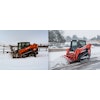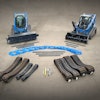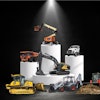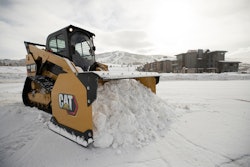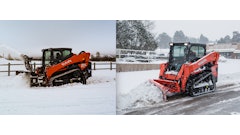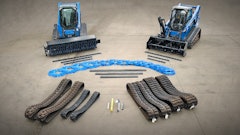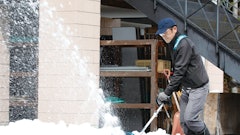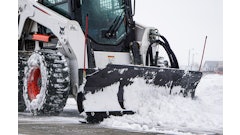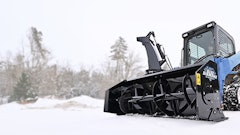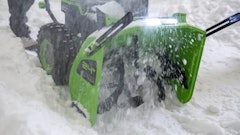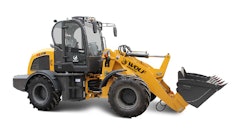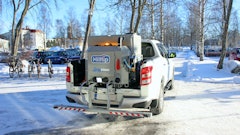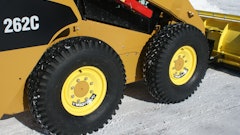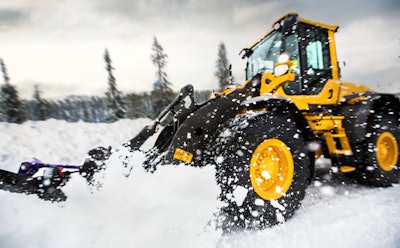
Preparation for plowing snow properly begins long before that first flake falls. Equipment, materials, storage, handling, mobilization and staffing planning, route mapping and a host of other details all need to be prepped before you can have a successful snow removal season. Prevent surprises and costly downtime this winter by doing everything possible to inspect and repair equipment now.
Prep the Plow
Your plow is the heart of your snow removal operation and you need to be sure everything that has to do with this piece of equipment is ready to go when the snow flies.
Some of the common areas that are covered during a pre-season plow inspection include:
- Changing the hydraulic fluid
- Greasing the vertical pin (on v-plows) and other important wear points
- Clean, inspect and grease all electrical connections
- Check all nuts and bolts for tightness
- Check the plow cylinders, hoses and pump for leaks
- Tighten the trip and return springs
- Inspect all welds in plow structure and vehicle mount
- Inspect and re-torque all fasteners on the vehicle mount
- Inspect the lights and properly adjust and align the plow lights
- Make sure all plow functions work properly
You should also make sure the truck is ready to operate. Check your vehicle’s tire pressure, engine belts for cracks and tightness, hoses for leaks and vehicle fluid levels including the engine oil, brake fluid, transmission fluid, battery, radiator coolant and windshield washer fluid. Examine the battery terminals for corrosion and make sure the connections are tight. Make sure the vehicle windshield wipers and defrosters are in good shape and working properly. Check the vehicle headlights, brake lights and turn signals to be sure they are in good working order, and make sure your strobe light is working if you have one. Also, look under the vehicle for obvious signs of leaking fluid.
NOTE: You should never run out of fuel, so make sure your fuel tank is full before going out to plow.
Add-On Attachments
Everyone knows it is important to assess your fleet in the off-months and plan for any new machines and attachments that need to be purchased for the upcoming season. In addition to your plow, there are other pieces of equipment to consider adding to your fleet for snow removal.
1. Brooms
Most brooms are capable of clearing snow up to 2 inches cleanly and down to the pavement, and can be used as soon as snow hits the ground. Brooms are designed to clear a typical sidewalk, which is 52 inches wide. The width of tires running the unit must fit within that footprint to avoid driving over and compacting unremoved snow, or disrupting lawn on either side of the pavement.
This makes them an ideal tool for zero-tolerance contractors who maintain busy, high-pedestrian properties. These kinds of customers—hospitals and retail establishments, for example—have the highest expectations of preventing slip and falls.
2. Blades
Simple pushing blades are a staple in the snow removal industry, come in all shapes and sizes, and fit almost any machine or application. Smaller blades work well on sidewalks and residential driveways, while large blades can be outfitted on a wheel loader for larger parking lots or roads.
3. Rear Power Take-Off Snow Blowers
There are two common types of rear power take-off (PTO) snow blowers, each operating on a slightly different method for snow removal. Rear-facing snow blowers are similar to common walk-behind snow blowers and are typically used for residential driveways. When used on a tractor and combined with a front blade, the operator can push snow, windrow or back-drag, then also use the rear-facing snow blower to move the snow pile with the same machine.
Inverted or drag-style snow blowers operate feature an auger that faces the tractor, the operator backs into a driveway, about 12 inches from the garage, for instance, then blows snow as the tractor drives away. The process, intended for professional use, is especially effective for contractors with very densely populated accounts or several within a neighborhood, as the operator can travel to and from each property on a tractor vs. needing to transport a unit with a truck or trailer.
4. Hydraulic Wing Pushers
The hydraulic wing pusher can operate in three unique ways, making it one of the most versatile and popular options for snow management, and appropriate for both commercial properties and residential driveways. The unit acts as a straight blade when wings face out, a containment plow when wings face forward or a back-drag plow when wings face back. An operator can windrow large areas, contain plow into piles, or back-drag from close areas, entryways, parking stalls or residential driveways.
5. Box Pushers
Box pushers are boxes that push snow while also containing the snow while pushing. Especially effective are box pushers with floating cutting edges. Rather than one long section of cutting edge, these small spring-loaded sections break up the pusher’s cutting edge into smaller sections that adjust to changes in terrain. This accommodating design results in better scraping down the pavement for cleaner results faster, and requiring fewer resources like salt and sand. These pushers are ideal for contractors servicing large commercial properties.
Stockpile Snow Essentials
Having the right fleet of equipment and attachments ready to go is not enough. It is equally important to plan ahead for the parts and service needs that will arise in season. Cold weather is rough on equipment. The equipment itself works hard. It is not a matter of “if” it will need parts, it is a matter of “when.”
Have as many back ups and spares on hand as possible. Murphy’s Law goes into hyper-drive when the temps head south of zero. Plan for fittings and hoses to leak or break, linkages to freeze, oil to congeal, fuel lines to ice up, salt and sand to freeze, metal to freeze and splinter, and in general for things to become hard to manage.
Downtime often comes at the most inopportune time, say, 2 a.m. or on Christmas Eve. When downtime can be solved with a simple part replacement or fluid fill, equipping the team to take care of it on their own is the fastest way to get back up and running. Customers who plan ahead to be as self-sufficient as possible tend to maximize uptime and remain most profitable.
Crew Check-In
Without your crew, your equipment means nothing. Make sure they are ready for the snow season as well. It's important that your drivers know how to operate the equipment properly and safely. Make sure your employees know how to drive safely in snow, whether they are plowing a parking lot or driving to the site. Plow operators should also be familiar with their routes in dry weather, making note of problem areas.
Safety is key with the trucks as well. Make sure you have your truck set up right in terms of safety with flashing lights, strobe lights, etc.
Check your first aid kits and spill clean-up kits, speedy dry, absorbent blankets, road flares, etc. Anything your crew may need should be ready to go.
Mother Nature will not reschedule her plans because you aren't prepared. Do everything you can now to be ready to serve your customers when the snow flies. And when the season ends, clean, repair and service your plows and spreaders before storing them at the end of the season to set yourself up for success for next year.

